

This is a Classical cultural tour of India and Nepal , covering all of the regions highlights. Start in the bustling metropolis of Delhi, enjoy the contrasts of Old & New, continue to the Pink City of Jaipur, in Agra, discover the sheer beauty of the Taj Mahal, then on to the impregnable fort of Gwalior, the temples and chattris of Orchha, on to exploring the famous Chandela temples of Khajuraho and visiting India’s holiest city, Varanasi on the banks of the Ganges River. The trip also takes you to Kathmandu, the capital of the Himalayan Kingdom of Nepal, famous for it’s temples and stupas.
Day 01 – Arrive Delhi
Your India and Nepal tour begins with an arrival in to Delhi, where you will be met at the airport by Pan India Tourism representative and transferred to the hotel and assisted with check in formalities.
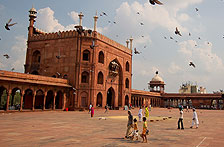 Delhi is the capital of India, and its third largest city. Delhi consists of two parts – New Delhi, the city created in 1911 as the imperial capital of India by the British and the Old Delhi, the Muslim capital of India between the 17th and 19th centuries. In fact there have been at least eight cities on the site of modern Delhi – the earliest known settlement, Indraprastha, featured in the epic Mahabharata over 3000 years ago. Though not always the capital, Delhi has always been an important city of northern region of the subcontinent.
Delhi is the capital of India, and its third largest city. Delhi consists of two parts – New Delhi, the city created in 1911 as the imperial capital of India by the British and the Old Delhi, the Muslim capital of India between the 17th and 19th centuries. In fact there have been at least eight cities on the site of modern Delhi – the earliest known settlement, Indraprastha, featured in the epic Mahabharata over 3000 years ago. Though not always the capital, Delhi has always been an important city of northern region of the subcontinent.
Overnight in Delhi.
Day 02 – In Delhi
After breakfast, you will be picked up from your hotel and taken for a guided sightseeing tour of Old & New Delhi. Tour includes visits to the following places of interest:
Red Fort: Derived from a Hindi word Lal, which means red and Quila which means fort. It is laid out along the river Yamuna as an irregular octagon, surrounded by a wall of about 2.4 kms in circumference and is built of red sandstone. Shah Jahan started construction of the massive fort in 1638 and it was completed in 1648. The fort has two main entrances, the Delhi Gate and the Lahori Gate, which faces the famed Chandni Chowk market. The fort has Diwan – e – Am (hall for public audience); Diwan – e – Khas (hall for private audience); Rang Mahal (a water-cooled apartment of royal ladies); Pearl mosque, built of white marble.
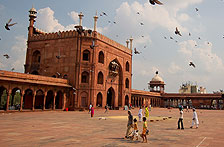 Jama Masjid: In Old Delhi, an architectural extravaganza of Shah Jahan, is the country’s largest mosque where thousands of Muslims offers prayers even today. It was built in 1658. The flight of stairs and its large courtyard are marvels of architecture.
Jama Masjid: In Old Delhi, an architectural extravaganza of Shah Jahan, is the country’s largest mosque where thousands of Muslims offers prayers even today. It was built in 1658. The flight of stairs and its large courtyard are marvels of architecture.
Chandni Chowk (Silver Street): It is the colourful main street and shopping bazaar of Old Delhi and is today one of the country’s best known wholesale market for textiles, electronic goods and watches. The entire area was designed by Jahanara Begum, Shah Jahan’s favourite daughter and was then inhabited by the well-to-do families of the time. Around the area is the famed Paranthawale Gali, known for its delicious paranthas, Dariba Kalan, the gold market and well-known sweetmeats shops.
Raj Ghat : On the banks of river Yamuna, a simple square platform of black marble marks the spot where Mahatma Gandhi was cremated following his assassination in 1948. A commemorative ceremony takes place each Friday, the day he was killed.
Birla Mandir: Close to Connaught Place, it was built by the industrialist Raja Baldev Birla in 1938. The temple is an important prayer site and contains idols of several deities.
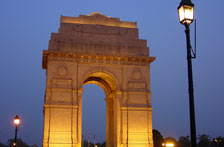 India Gate: This 42 meter high, free standing arch was built in 1931.It was originally called All India War Memorial in the memory of the 90,000 soldiers of the Indian Army who died in World War I. The names of the soldiers are inscribed all along the walls of the arch. In 1971, the eternal flame was lit here to honour the Amar Jawan (Immortal Soldier).
India Gate: This 42 meter high, free standing arch was built in 1931.It was originally called All India War Memorial in the memory of the 90,000 soldiers of the Indian Army who died in World War I. The names of the soldiers are inscribed all along the walls of the arch. In 1971, the eternal flame was lit here to honour the Amar Jawan (Immortal Soldier).
Rashtrapati Bhavan (President’s House): It is the official residence of President of the country. Designed by Lutyens, it was the official residence of the Viceroy when the British ruled India.
Humayun’s Tomb: It was built by Haji Begum (widow of Humayun) in 1565 – 66, nine years after his death.
Qutub Minar: This magnificent structure in the southern part of the capital was built by the Muslim King; Qutab – ud – din Aibak in 1199 A.D. Minar (tower) is 72.5 meters high and has as its base a mosque.
Bahai’s Temple: It is a very recent architectural marvel of the Bahai faith and is visible from several spots in South Delhi. It is a lotus shaped and has rightly been given the name.
Overnight in Delhi.
Day 03 – Drive Delhi – Jaipur (265 kms/05 hrs)
After leisurely breakfast at hotel, you will be met by our representative and assisted with check-out formalities. You will then start your drive to Jaipur.
Jaipur - is the capital of Rajasthan, and known as the “Pink City” because of the pink colored buildings in its old city. It is situated on a dry lakebed in a somewhat arid landscape, surrounded by barren hills surmounted by forts and crenellated walls. Founded in 1727 by Maharaja Jai Singh II, who was careful to cultivate good favour with the ruling Mughals, he laid out the city with rectangular blocks according to ancient Hindu architecture. It is a wonderful city for shopping.
On arrival at Jaipur hotel, you will be met by our representative and assisted with check in formalities.
Overnight in Jaipur.
Day 04 – In Jaipur
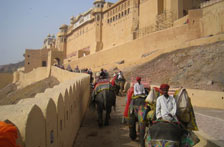 After breakfast, you will be picked up from your hotel and taken for a guided sightseeing tour of Jaipur and Amber. Tour includes visits to the following places of interest:
After breakfast, you will be picked up from your hotel and taken for a guided sightseeing tour of Jaipur and Amber. Tour includes visits to the following places of interest:
Hawa Mahal (Palace of winds): Built by Maharaja Sawaj Pratap Singh in 1799, the Hawa Mahal is one of Jaipur’s major landmarks, the facade of which is all pink windows and filigree screens. It was originally built to enable ladies of the royal household to watch the everyday life and processions of the city.
City Palace: It is still the home of the former royalty H.H Bhawani Singh Ji of Jaipur housing an extensive collection of art, carpets and old weapons.
Jantar Mantar (Observatory): It was built by Maharaja Jai Singh in 1728. At first glance, Jantar Mantar appears to be a curious collection of sculptures but in fact each construction has a specific purpose such as measuring the positions of stars, altitudes and azimuths, and calculating eclipses. The most striking instrument is the sundial with its 27 meter high gnomon. The shadow this casts moves up to 4 meter an hour.
Amber Fort: The Amber Fort is situated 11 kms away from Jaipur. Amber was once the ancient capital of Jaipur state. The Fort is a superb example of Rajput architecture, stunningly situated on a hillside and overlooking a lake, which reflects its terraces and ramparts. The climb to the fort is on gaily-bedecked elephants.
Overnight in Jaipur
Day 05 – Drive Jaipur – Agra (250 kms/05 hrs)
After leisurely breakfast, you will be met by our representative and assisted with check-out formalities. You will then start your drive to Agra. Stop enroute at Fatehpur Sikri for guided tour of this ancient capital.
Fatehpur Sikri: the deserted capital of Emperor Akbar approximately 35 kms outside Agra. Built in the 16th century, this city was abandoned 12 years later due to a scarcity of water. The entire city of Red sand stone (sand stone palaces and temples) is virtually intact and a site worth seeing is the 54 m high main entrance - The Buland Darwaza, The gate of victory constructed to commemorate Akbar’s victory in Gujarat.
After the visit, continue your drive to Agra.
Agra, situated on the bank of Yamuna River, is home to India’s most famous landmark, the Taj Mahal. Agra was the capital of Mughal Empire in the 16th & 17th centuries and its superb monuments date from this era
On arrival at Agra hotel, you will be met by our representative and assisted with check in formalities.
Afternoon guided sightseeing tour of Agra visiting :
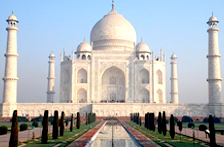 Taj Mahal: The Taj Mahal was constructed by Emperor Shah Jahan in memory of his wife Mumtaj Mahal who died during the birth of her child in 1631. The construction is said to have taken 22 years to complete, starting from 1631, with over 20,000 craftsmen working round the clock. Artisans and experts were brought from France and Italy and the main architect was from Iran.
Taj Mahal: The Taj Mahal was constructed by Emperor Shah Jahan in memory of his wife Mumtaj Mahal who died during the birth of her child in 1631. The construction is said to have taken 22 years to complete, starting from 1631, with over 20,000 craftsmen working round the clock. Artisans and experts were brought from France and Italy and the main architect was from Iran.
Agra Fort: Construction of the massive red sandstone Agra Fort on the bank of Yamuna River was begun by Emperor Akbar in 1565 and it was to be predominantly a military structure until his grandson, Shah Jahan, added more palatial accommodations. There are a number of exquisite buildings within its portals such as Samman Burj, where Shah Jahan was held captive by his son, Moti Masjid, a white marble mosque, Diwan – e – Am, Diwan – e – Khas, Jahangir’s Palace, Khaas Mahal and Shish Mahal.
Overnight in Agra.
Day 06 – Drive Agra – Gwalior (120 kms/03 hrs)
After leisurely breakfast, you will be met by our representative and assisted with check-out formalities. You will then start your drive to Gwalior.
Gwalior – Situated in the state of Madhya Pradesh, is the city of true royals, the Scindias. City is well known for its majestic fort, considered as one of the best in the world. The huge Gwalior fort that dominates this dry & dusty city witnessed the rise and fall of many dynasties which have held sway over the centuries. Once resplendent in gold mosaic tiles, the main palace, Man Mandir, still exhibits intricate carvings and art from the 9th century and the dungeons below give a graphic illustration of the Mogul prisoners’ fate. This fort has been described by Babur as 'the pearl among the fortresses of Hind'.
On arrival at Gwalior hotel, you will be met by our representative and assisted with check in formalities.
Afternoon, guided sightseeing tour of Gwalior visiting the Gwalior Fort, Museum, Rani Laxmibai Memorial and Tansen’s Tomb.
Overnight in Gwalior.
Day 07 – Drive Gwalior – Orchha (120 kms/03 hrs)
After leisurely breakfast at hotel, you will be met by our representative at hotel and assisted with check out formalities. You will then start your drive to Orchha.
Orchha - In the central part of India, once the capital of Bundela rulers, is now a village set among a wonderful complex of well-preserved palaces and temples which date back to the 16th century. Many of the temples are still in use and are visited regularly by thousands of devotees who go there to worship at the shrine of Rama. A relatively undiscovered spot it is definitely worth visiting Orchha for its peaceful beauty. Strewn around the area are little shrines and memorials, each with its own poignant history, each contributing to the nostalgic beauty that is Orchha.
On arrival at Orchha, check into the Orchha Resort,
Afternoon, guided sightseeing tour of Orchha. The tour of Orchha takes you to the Jehangir mahal - the largest of the palaces, the Raj mahal with its murals and the Raj Praveen mahal built near a garden, the Chaturbhuj temple and the Royal Chhattris by the Betwa river.
Overnight at Orchha Resort.
Day 08 - Drive Orchha – Khajuraho (170 kms/3.5 hrs)
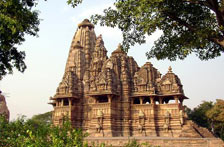 After leisurely breakfast, you will be met by our representative and assisted with check-out formalities. You will then start your drive to Khajuraho.
After leisurely breakfast, you will be met by our representative and assisted with check-out formalities. You will then start your drive to Khajuraho.
Khajuraho: - Khajuraho was once the capital of the Chandela Rajputs of Bundelkhand. It is home to the world famous 10th century Khajuraho temples. These temples represent some of the most exquisite specimens of medieval Hindu architecture and sculpture in the country.
On arrival at Khajuraho hotel, you will be met by our representative and assisted with check in formalities
Afternoon, you will be picked up from your hotel and taken for a guided sightseeing tour of Khajuraho. Tour includes visits to the following places of interest:
Eastern Group Of Temples – It’s includes the Lakshmi and Varaha Temple, the Lakshmana Temple, the Kandariya Mahadev, the Mahadeva Temple; the Devi Jagadamba Temple, the Chitragupta Temple and the Vishwanath Temple.
Western Group Of Temples - Also houses the Matangesvara Temple, the only temple where worship continues and the Chausath Yogini Temple, presently in ruins and believed to be the oldest temple in Khajuraho. The Eastern Group of temples houses the Parasvanath Temple, the largest and finest Jain temple in the city as well as the Adinath Temple, the Shantinath Temple, the Ghantai Temple, the Javari Temple, the Vamana Temple and the Brahma and Hanuman Temple.
Overnight in Khajuraho.
Day 09 – Fly Khajuraho – Varanasi
After breakfast at hotel, you will be met by our representative at hotel and assisted with check out formalities. You will then be transferred to the airport in time to board flight for Varanasi.
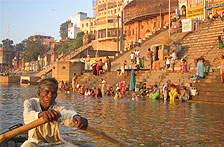 Varanasi - Varanasi, the ‘eternal city’ is one of the most important pilgrimage sites in India and also a major tourist attraction. Situated on the banks of the sacred Ganges, Varanasi has been a center of learning for over 2000 years. Besides being a pilgrimage center, it is considered an auspicious place to die, ensuring an instant route to heaven. Varanasi is still a center of learning, especially for Sanskrit scholars, and students flock here from all over India.
Varanasi - Varanasi, the ‘eternal city’ is one of the most important pilgrimage sites in India and also a major tourist attraction. Situated on the banks of the sacred Ganges, Varanasi has been a center of learning for over 2000 years. Besides being a pilgrimage center, it is considered an auspicious place to die, ensuring an instant route to heaven. Varanasi is still a center of learning, especially for Sanskrit scholars, and students flock here from all over India.
The old city of Varanasi is situated along the west bank of the Ganges and extends back from the riverbank ghats in a winding collection of narrow alleys. They’re too narrow for anything but walking and tall houses overhang the picturesque, though hardly clean, lanes. The town extends from Raj Ghat, near the bridge, to Asi Ghat, near the university.
You will be met at the Varanasi airport by our representative and transferred to the hotel and assisted with check in formalities.
Afternoon, you will be picked up from your hotel for the guided tour of Varanasi. Tour includes visits following places of interest:
Asi Ghat: It is one of the five special ghats which pilgrims are supposed to bathe from in order and on the same day. The order is Asi, Dasaswamedh, Barnasangam, Panchganga and finally Manikarnika.
Durga Temple: It is commonly known as the Monkey Temple due to the many monkeys that have made it their home. It was built in the 18th century by a Bengali maharani and is stained red with ochre. The small temple is built in North Indian Nagara style with a multi-tiered shikharas (spires). This temple is also closed to non-Hindus, however, you can look down on the temple from a walkway at the top.
Kashi-Vishwanath Or Golden Temple: Dedicated to Vishveswara Siva as the Lord of the Universe, the Golden Temple is across the road from its original position. Aurangzeb destroyed the original temple and built a mosque over it – traces of the earlier 1600 temple can be behind his mosque. The present temple was built in 1776 by Ahalya Bai of Indore, and the gold plating on the towers was provided by Maharaja Ranjit Singh of Lahore. Next to the temple is the Gyan Kupor Well – the well of knowledge. Non-Hindus are not allowed into the temple but can view it from upstairs in a house across the street.
Overnight in Varanasi.
Day 10 – Fly Varanasi – Kathmandu
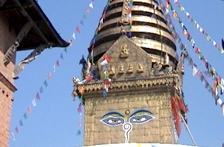 The day starts early with a dawn boat ride on the holy river The Ganges. Your guide and driver will pick you up from your hotel and take you to the river Ganges. At dawn, the city and the river are coming alive, the light is magical and Varanasi looks an exotic place. A highlight of any trip to Varanasi - this is an incredible scene, as multitudes of devotees comes to the river to pay homage to the Sun God. The riverfront, as seen from a boat at sunrise, is a spiritually uplifting sight. Hinduism, deep and mystical, is everywhere: in a decorated doorway; in a glimpse of a glittering temple; in the sound of a sacred bell; in the chant of the priests; and in the fragrance of flower oblations.
The day starts early with a dawn boat ride on the holy river The Ganges. Your guide and driver will pick you up from your hotel and take you to the river Ganges. At dawn, the city and the river are coming alive, the light is magical and Varanasi looks an exotic place. A highlight of any trip to Varanasi - this is an incredible scene, as multitudes of devotees comes to the river to pay homage to the Sun God. The riverfront, as seen from a boat at sunrise, is a spiritually uplifting sight. Hinduism, deep and mystical, is everywhere: in a decorated doorway; in a glimpse of a glittering temple; in the sound of a sacred bell; in the chant of the priests; and in the fragrance of flower oblations.
Return to hotel. After leisurely breakfast, you will be met by our representative and assisted with check-out formalities. You will then be transferred to the airport in time to board flight for Kathmandu, the last stop of your India and Nepal tour.
Kathmandu –Locked between India and Tibet the tiny kingdom of Nepal is a country full of diversity and fascination. It is a hidden Kingdom of great beauty embracing eight of the world's ten highest mountains including Everest, Annapurna and Kangchenjunga. The scenery is stupendous, from the highest point on earth (Mount Everest) to the fertile jungle lowland. Although its people are predominantly Hindu, there is a considerable overlap with Buddhism, and it is this vibrant mix of religion and culture which characterises the allure of Nepal and, in particular, its capital Kathmandu. It has an artistic and architectural tradition that rivals anything you will find in the great cities of Europe. Beyond the temples and bustle of the towns of the Kathmandu Valley rise the mountains of the Nepal Himalaya - the 'Abode of Snows'.
Upon clearing Customs and Immigration, You will be met at the airport by Pan India Tourism representative and transferred to the hotel and assisted with check in formalities.
No activity is scheduled for this today.
Overnight in Kathmandu.
Day 11 –In Kathmandu
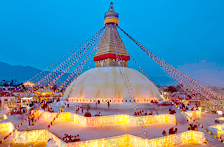 After breakfast, you will be picked up from your hotel and taken for a guided sightseeing tour of Kathmandu . Tour includes visits to the following places of interest:
After breakfast, you will be picked up from your hotel and taken for a guided sightseeing tour of Kathmandu . Tour includes visits to the following places of interest:
Pashupatinath - which is the holiest Hindu pilgrimage destination in Nepal. There are linga images of Shiva along with statues, shrines, and temples dedicated to other deities in the complex. A temple dedicated to Shiva existed at this site in AD 879. However, the present temple was built by King Bhupatindra Malla in 1697. A gold-plated roof, silver doors, and woodcarvings of the finest quality decorate the pagoda construction.
Bodhnath - it is among the largest stupas in South Asia, and it has become the focal point of Tibetan Buddhism in Nepal. The white mound looms thirty-six meters overhead. The stupa is located on the ancient trade route to Tibet, and Tibetan merchants rested and offered prayers here for many centuries. When refugees entered Nepal from Tibet in the 1950s, many of them decided to live around Bouddhanath. They established many gompas, and the "Little Tibet" of Nepal was born.
Bhadgaon - Bhadgaon also known as Bhaktapur is the third largest city in the Kathmandu valley. The city was once the capital of Nepal during the great Malla Kingdom from the 12th to the 15th century. Main attractions in Bhadgaon are ....
Bhaktapur Durbar Square: One of the world heritage sites in the country which reflects the city's rich culture, art and architectural design, it is also the central setting of the city for architectural monuments and arts. The golden gate is the entrance to the main countyard of the Palace of 55 windows, the gate is regarded as the world's most beautiful and richly carved specimens of its kind. Bhaktapur
Nyatapol Temple :This temple is 30 meter tall, and is the tallest temple in the Kathmandu valley. It was built by King Bhupatindra Malla in 1708 AD. Each of its five terrace holds a pair of figures, starting from bottom wrestlers, elephant, lion, griffins and goddesses. The Bhaktapur National Art Gallery : It is Located in the Bhaktapur Durbar Square. Rare paintings, and manuscripts with painted covers and illustrations can be found in this museum. Gallery contains brass, bronze, stone and wooden images, gallery is explored by tourists for medieval art tradition of Nepal.
Overnight in Kathmandu.
Day 12 – In Kathmandu
After leisurely breakfast, you will be picked up from your hotel and taken for a guided sightseeing tour of Kathmandu . Tour includes visits to the following places of interest:
Kathmandu Durbar Square - a number of interesting pagodas and Indian style temples (Sikhara), the House of Kumari (the living Goddess) and the Kasthamandap (or wooden house which is the origin of the word Kathmandu) and many more things to see.
Sawayambhunath - The monkey temple, with its commanding views of Kathmandu, its whitewashed stupas and its unique synthesis of Buddhist and Hindu religions.
Hanuman Dhoka – a temple complex in the middle of the old city. Built during the Malla period, the area consists of a number of different monuments & image of Lord Hanumana.
Rest of the day at leisure to explore the city on your own.
Overnight in Kathmandu.
Day 13 – Depart Kathmandu
After leisurely breakfast at hotel, you will be met by our representative and assisted with check-out formalities. You will then be transferred to the airport in time for your flight home. If you have a bit more time available, your India and Nepal tour, can also be combined with a tour to Bhutan.
Period |
Standard |
Deluxe |
Elite |
1st Oct to |
Us$ 1693 Per Pax |
Us$ 1940 Per Pax |
Us$ 2472 Per Pax |
6th April to |
Us$ 1473 Per Pax |
Us$ 1670 Per Pax |
Us$ 2102 Per Pax |
Domestic airfare |
Us$ 365 Per Pax |
Us$ 365 Per Pax |
Us$ 365 Per Pax |
Cities |
Standard |
Deluxe |
Elite |
Delhi |
The Connaught |
The Claridges |
Taj Palace |
Jaipur |
Shahapura House / Alsisar Haveli |
Lemon Tree Premier |
Jai Mahal Palace |
Agra |
Howard Plaza |
Taj Gateway |
ITC Mughal |
Gwalior |
Usha Kiran Palace |
Usha Kiran Palace |
Usha Kiran Palace |
Orchha |
Orchha Resort |
Orchha Resort |
Orchha Resort |
Khajuraho |
Ramada |
Radisson |
Taj Chandela |
Varanasi |
HHI Varanasi |
Radisson |
Taj Gateway |
Kathmandu |
Himalaya |
Radisson |
Hyatt Regency |
Small supplements may apply for travel between 23rd October and 30th October, 05th November and 20th November, 20th December and 05th January and during the month of February .
Note:All the figures quoted above are nett per person in US Dollars.
Inclusions:
Pan India Tourism
Unit of - AABYO SWACH YATRA HOSPITALITY PVT. LTD
Phone: 044-43595695
Cell: +91-75 300 25 888,
+91-9789930293, +91-9789080806, +91-9746125967
email: info@panindiatourism.com



